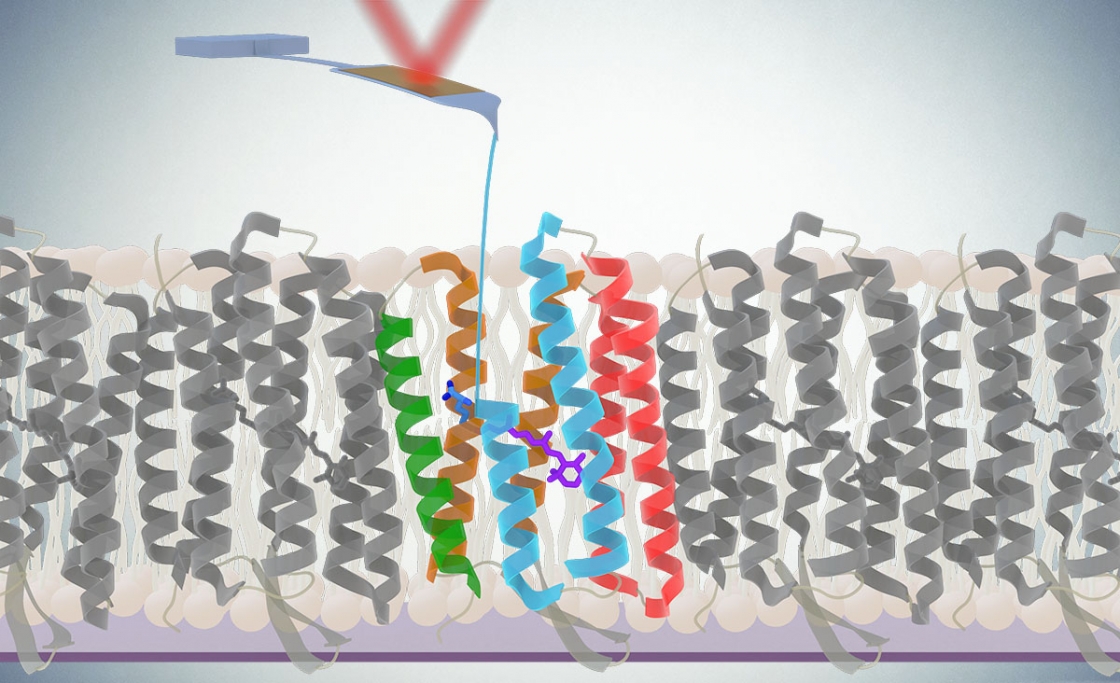Cells are surrounded by a membrane containing carefully folded proteins. Those membrane proteins interact with the watery environment inside and outside the cell and the fatty environment of the membrane that keeps the inside and the outside of the cell separated.
That gives them an important role-they are how the inside of the cell talks to the outside of the cell, allowing viruses to attack or letting in medications to treat disease, said David Jacobson, a post-doc in the Perkins Group at JILA. That's why roughly half of proposed and current drugs target membrane proteins.
Studying these membrane proteins is crucial for biomedical research, but they are tricky to measure in a lab. Many biochemical techniques for measuring membrane proteins remove them from their native bilayer by washing them in a detergent-potentially altering how they interact with their surroundings or how they are folded.
The Perkins Group has worked out a method of measuring membrane proteins using atomic force microscopy (AFM) tools. In a new study published on August 5 in Physical Review Letters, the team uses AFM to unfold and refold bacteriorhodopsin-a membrane protein found in microorganisms called archaea-precisely measuring the free energy it takes to do so and demonstrating a new means of studying and manipulating the proteins.
Unfolding and refolding
While a membrane protein is linear chain of amino acids, it folds into a unique three-dimensional structure. This three-dimensional structure depends on interactions between amino acids that make up the protein, which is what the Perkins Group wants to measure. One way to measure the strength and nature of those interactions is to grab the end of the protein chain with the AFM tip and pull, unfolding the protein structure.
"If we exert enough force, it starts to unfold," Jacobson explained. "The unfolding force is related to the strength of the interaction that holds the proteins together. The stronger the stabilizing interactions, the more force it takes to pull it apart."
Biophysicists, including the Perkins Group, have been doing this for years, Jacobson said-usually with brute force, thrusting the AFM tip into the membrane protein. That works, but it doesn't stick very well, which makes it difficult to perform multiple measurements, Jacobson added. Previous studies measured the force to unfold the entire structure and divided it among the 248 amino acids in the protein.
To make a more precise measurement, the Perkins Group chemically treated the 10-nanometer AFM tip so it bonds with the amino acids at the end of the protein. Then, they gently touch the tip to the very end of the protein chain and pull-only enough to unravel five or eight amino acids.
As the amino acids unfold, the cantilever holding the AFM tip flexes. Then the scientists relax the tension, allowing the small segment of amino acids to fold back into their shape.
Measuring the cantilever's flex with each unfold and refold tells scientists how much free energy is required to manipulate this protein structure. And this method can be done in the membrane's native bilayer, replicating its native environment.
Rebuilding new structures
Precisely manipulating a few amino acids opens the door to understanding an individual amino acid's role in the cell's function, Jacobson pointed out.
"All the chemistry of the cell is driven by proteins and a lot of the structure of the cell is made of proteins. The proteins don't work if they are not folded up into their correct three-dimensional structure. The three-dimensional structure depends on the interactions between the amino acids," he said.
This method also allows scientists to make changes and mutations to those amino acids, and study the effect of those changes.
"In principle, this technique can be applied to any membrane proteins...It opens the door to measuring, making mutation studies to measure the contribution of these individual amino acids to the overall stability of the protein," Jacobson added.
This study was supported by the National Science Foundation, including the Physics Frontier Center grant.
Written by Rebecca Jacobson



 The Physics Frontiers Centers (PFC) program supports university-based centers and institutes where the collective efforts of a larger group of individuals can enable transformational advances in the most promising research areas. The program is designed to foster major breakthroughs at the intellectual frontiers of physics by providing needed resources such as combinations of talents, skills, disciplines, and/or specialized infrastructure, not usually available to individual investigators or small groups, in an environment in which the collective efforts of the larger group can be shown to be seminal to promoting significant progress in the science and the education of students. PFCs also include creative, substantive activities aimed at enhancing education, broadening participation of traditionally underrepresented groups, and outreach to the scientific community and general public.
The Physics Frontiers Centers (PFC) program supports university-based centers and institutes where the collective efforts of a larger group of individuals can enable transformational advances in the most promising research areas. The program is designed to foster major breakthroughs at the intellectual frontiers of physics by providing needed resources such as combinations of talents, skills, disciplines, and/or specialized infrastructure, not usually available to individual investigators or small groups, in an environment in which the collective efforts of the larger group can be shown to be seminal to promoting significant progress in the science and the education of students. PFCs also include creative, substantive activities aimed at enhancing education, broadening participation of traditionally underrepresented groups, and outreach to the scientific community and general public.